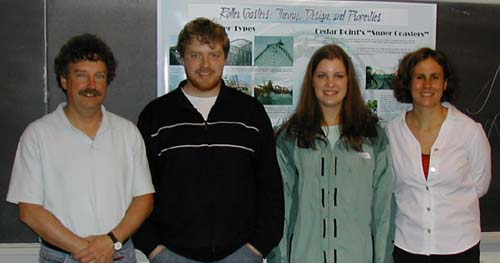

At a conference in January 2003, a few mathematicians began to discuss their love of roller coasters. Among this group were Chip Ross and Meredith Greer, both from Bates College. Conversation soon turned to comments like "there should be a math class on roller coasters!" After returning to Bates, Chip and Meredith put the planning process in motion.
Many people at Bates have worked hard to secure funding for various faculty and student projects. One of the best math and science sources currently available is a grant from the Howard Hughes Medical Institute. During the academic year 2003-2004, we applied to Bates for curriculum development money and received enough to hire two students for the summer of 2004. Those students were Leslie Milk '05 and Nate Stambaugh '06.

During Summer 2004, Nate, Leslie, Chip, and Meredith worked together to design a Short Term unit about roller coasters. Our tasks included:
Many of these tasks turned out to be quite difficult. In particular: how were we to offer a class at the right level? There are many middle or high school activities publicly available, such as for Physics Days at amusement parks. We, however, expected to use at least one semester of calculus, along with lots of geometry and trigonometry. Without a doubt, the most effort went into researching math and physics as they relate to roller coaster design. We were helped tremendously by Hong Lin in the Physics Department, who gave generously of her time, creativity, and expertise.
We were extremely lucky, too, to have so much help from other people around campus. Several members of the physics department shared their ideas, advice, and demonstration equipment, starting before our summer of curriculum development and continuing still. The Physical Plant at Bates was happy to provide workspace where we could build model roller coaster tracks, and many of the workers there stopped in regularly to see how track construction was going. They were truly interested in our progress, and offered advice on how to better use their equipment to achieve our goals. In particular, John Griffiths, the head of Physical Plant, helped us initially set up, then checked in often to make sure we had what we needed. Other campus help included Ray Potter, the Environmental Health and Safety Specialist at Bates, who aided us as we started work at Physical Plant. Then, when it first became clear that we could build model roller coasters, the Dean of Faculty's office facilitated our use of grant money to purchase materials. They made the process as quick as possible so that we could best devote those summer weeks to our work. We were all truly impressed by the friendliness, helpfulness, and enthusiasm of so many Bates employees.
Our Roller Coasters class was offered for the first time during Short Term 2005. The twelve students in the class went on a trip to Cedar Point Amusement Park and came up with fascinating and creative ideas for projects. For pictures and short movies from our trip, and for descriptions of projects, please visit our photos and videos page.
Roller Coasters Home Page | History of the Class | Class Calendar | Animations | Photos and Videos | Syllabus | Bates Mathematics Department
All content above relates to Math s45K, Roller Coasters: Theory, Design, and Properties, offered during Short Term 2005 at Bates College in Lewiston, Maine.